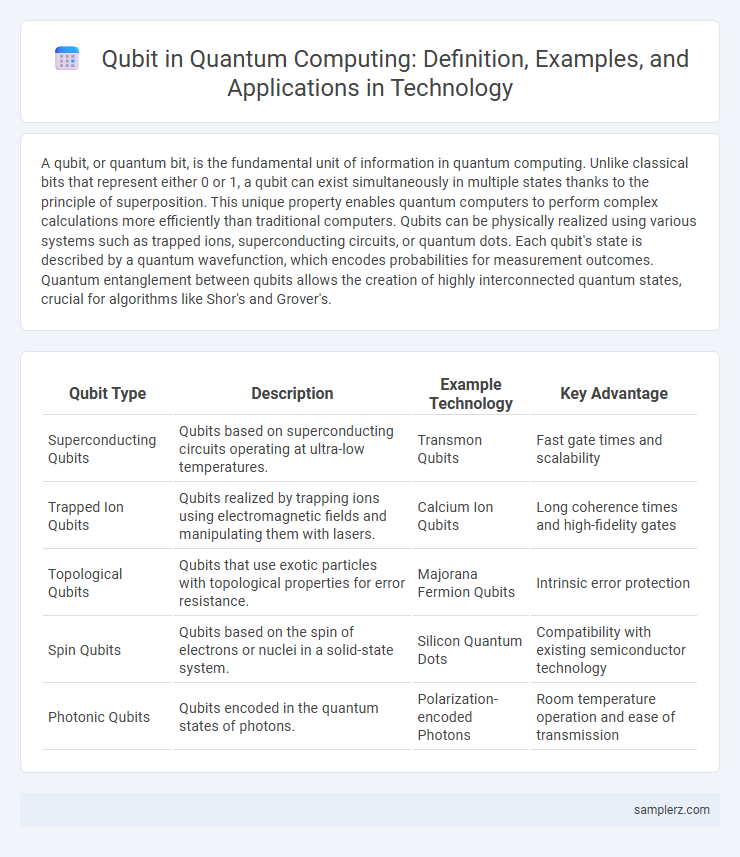A qubit, or quantum bit, is the fundamental unit of information in quantum computing. Unlike classical bits that represent either 0 or 1, a qubit can exist simultaneously in multiple states thanks to the principle of superposition. This unique property enables quantum computers to perform complex calculations more efficiently than traditional computers. Qubits can be physically realized using various systems such as trapped ions, superconducting circuits, or quantum dots. Each qubit's state is described by a quantum wavefunction, which encodes probabilities for measurement outcomes. Quantum entanglement between qubits allows the creation of highly interconnected quantum states, crucial for algorithms like Shor's and Grover's.
Table of Comparison
| Qubit Type | Description | Example Technology | Key Advantage |
|---|---|---|---|
| Superconducting Qubits | Qubits based on superconducting circuits operating at ultra-low temperatures. | Transmon Qubits | Fast gate times and scalability |
| Trapped Ion Qubits | Qubits realized by trapping ions using electromagnetic fields and manipulating them with lasers. | Calcium Ion Qubits | Long coherence times and high-fidelity gates |
| Topological Qubits | Qubits that use exotic particles with topological properties for error resistance. | Majorana Fermion Qubits | Intrinsic error protection |
| Spin Qubits | Qubits based on the spin of electrons or nuclei in a solid-state system. | Silicon Quantum Dots | Compatibility with existing semiconductor technology |
| Photonic Qubits | Qubits encoded in the quantum states of photons. | Polarization-encoded Photons | Room temperature operation and ease of transmission |
Defining Qubits: The Building Blocks of Quantum Computing
Qubits, or quantum bits, represent the fundamental units of information in quantum computing, capable of existing in superposition states unlike classical bits that are strictly 0 or 1. Common physical implementations include superconducting circuits, trapped ions, and quantum dots, each enabling manipulation of qubit states through quantum gates. These qubits form the foundation for quantum algorithms, facilitating exponential speed-up in solving complex problems such as factoring large numbers and simulating molecular structures.
Physical Realizations of Qubits
Superconducting qubits, such as transmon qubits, utilize Josephson junctions to achieve quantum coherence and are widely implemented in quantum processors by companies like IBM and Google. Trapped ion qubits rely on electromagnetic fields to confine individual ions, offering long coherence times and high-fidelity quantum gates. Topological qubits leverage exotic particles called anyons in topological superconductors to provide robust error resistance, representing a promising direction for fault-tolerant quantum computing.
Superconducting Qubits: An Industry Example
Superconducting qubits, utilized by companies like IBM and Google, rely on superconducting circuits cooled to near absolute zero to create and manipulate quantum states. These qubits exhibit coherence times sufficient for executing complex quantum algorithms and are fabricated using advanced lithographic techniques compatible with existing semiconductor manufacturing. Their scalability and integration with classical electronics make them a leading platform in the race toward practical quantum computing applications.
Trapped Ion Qubits in Practice
Trapped ion qubits utilize individual ions confined and manipulated using electromagnetic fields to perform quantum computations with high fidelity. These qubits offer exceptional coherence times and precise control through laser-based techniques, making them ideal for scalable quantum processors. Practical implementations in laboratories demonstrate robust entanglement generation and error correction protocols essential for advancing quantum computing technology.
Photonic Qubits and Their Applications
Photonic qubits use the polarization or phase of individual photons to encode quantum information, offering high-speed transmission and low decoherence rates in quantum computing systems. Applications include secure quantum communication through quantum key distribution, scalable quantum networks, and optical quantum processors that leverage the unique properties of light for efficient quantum operations. These features make photonic qubits instrumental in developing practical quantum technologies for future information processing challenges.
Spin Qubits in Semiconductor Quantum Dots
Spin qubits in semiconductor quantum dots represent a leading platform for quantum computing due to their long coherence times and scalability. These qubits leverage the electron's spin state confined within nanoscale semiconductor structures, enabling precise quantum state manipulation using electric and magnetic fields. Advances in materials like silicon and gallium arsenide have facilitated improved control and integration of spin qubits with existing semiconductor technologies.
Topological Qubits: A Future Prospect
Topological qubits, leveraging the properties of anyons and non-abelian statistics, promise enhanced error resistance compared to conventional qubits in quantum computing. These qubits encode information in the global state of particles, making them less susceptible to local disturbances and decoherence. Advances in materials like Majorana zero modes within topological superconductors are pivotal for realizing scalable and fault-tolerant quantum systems based on topological qubits.
Comparing Qubit Implementations in Leading Quantum Computers
Superconducting qubits, employed by IBM and Google, leverage Josephson junctions to achieve fast gate speeds and scalability, making them dominant in current quantum processors. Trapped ion qubits, utilized by IonQ and Honeywell, offer exceptional coherence times and high-fidelity operations through electromagnetic trapping of individual ions. Topological qubits, explored by Microsoft, aim to enhance error resistance by encoding information in anyons, though they remain in experimental stages compared to more mature superconducting and ion trap technologies.
Real-World Use Cases Demonstrating Qubits
Qubits enable breakthroughs in cryptography by powering quantum key distribution protocols that enhance secure communication beyond classical limits. In pharmaceutical research, qubits simulate complex molecular interactions, accelerating drug discovery processes and reducing development costs. Additionally, optimization problems in logistics and finance benefit from qubit-driven quantum annealers, improving solution accuracy and computational speed compared to traditional methods.
Challenges and Future Trends in Qubit Development
Qubit development in quantum computing faces significant challenges such as maintaining coherence time, error rates, and scalability of qubit arrays. Current research emphasizes the improvement of quantum error correction codes and the exploration of topological qubits to enhance stability and fault tolerance. Future trends point toward integrating hybrid qubit systems and leveraging advancements in materials science to enable more practical and large-scale quantum processors.

example of qubit in quantum computing Infographic
 samplerz.com
samplerz.com